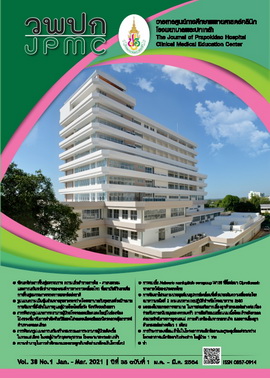การพบเชื้อ Neisseria meningitidis serogroup W135 ที่ดื้อต่อยา Ciprofloxacin ทางภาคใต้ของประเทศไทย
Main Article Content
บทคัดย่อ
ที่มาของปัญหา: โรคไข้กาฬหลังแอ่นเกิดจากการติดเชื้อ Neisseria meningitis ซึ่งยังพบการระบาดอยู่ในกลุ่มประเทศพัฒนาและกำลังพัฒนารวมถึงประเทศไทย ผู้สัมผัสใกล้ชิดจำเป็นต้องได้ยาป้องกันการติดเชื้อโดยเร็ว เนื่องจากมีโอกาสติดเชื้อและป่วยเป็นโรคไข้กาฬหลังแอ่นได้สูง ยาที่แนะนำในปัจจุบันคือยา Rifampicin หรือ Ciprofloxacin ซึ่งยา Ciprofloxacin ได้รับความนิยมมากกว่า เนื่องจากการบริหารยาเป็นแบบ เม็ดเดียว ครั้งเดียว ในขณะที่ Rifampicin ต้องกิน วันละ 2 ครั้ง เป็นเวลา 2 วัน อย่างไรก็ตาม ในต่างประเทศเริ่มมีรายงานเชื้อ Neisseria meningitidis ที่ดื้อต่อยา Ciprofloxacin แต่ยังไม่มีรายงานในประเทศไทย
วัตถุประสงค์: เพื่อหาความไวของเชื้อ Neisseria meningitidis ต่อยา Ciprofloxacin ตั้งแต่เดือนกันยายน พ.ศ. 2552 ถึงเดือนกันยายน พ.ศ. 2561
วิธีการศึกษา: เป็นการศึกษาย้อนหลังโดยการทบทวนเวชระเบียนผู้ป่วยของโรงพยาบาลสงขลาที่มีผลเพาะเชื้อยืนยันว่ามีการติดเชื้อ Neisseria meningitidis โดยเก็บข้อมูลทั่วไป อาการ อาการแสดง ผลความไวต่อยา Ciprofloxacin และ Serogroup ของเชื้อ
ผลการศึกษา: พบว่า มีผู้ป่วยจำนวน 11 รายที่มีผลการเพาะเชื้อยืนยัน โดยเป็นเด็ก 4 รายและผู้ใหญ่ 7 ราย ไม่พบผู้เสียชีวิต เชื้อ Neisseria meningitidis ที่พบในช่วงปี พ.ศ. 2552-2560 เป็น Serogroup B และไวต่อยา Ciprofloxacin คิดเป็นร้อยละ 100 แต่หลังจากปี พ.ศ. 2560 พบว่า เป็น Serogroup W135 และดื้อต่อยา Ciprofloxacin คิดเป็นร้อยละ 100 แต่ก็ยังคงไวต่อยา Ceftriaxone
สรุป: การค้นพบเชื้อ Neisseria meningitidis serogroup W135 ซึ่งดื้อต่อยา Ciprofloxacin ทางภาคใต้ของประเทศไทย ทำให้ต้องมีการทบทวนการใช้ยา Ciprofloxacin ในการป้องกันการติดเชื้อสำหรับผู้สัมผัสใกล้ชิด
Article Details
เอกสารอ้างอิง
Jafri RZ, Ali A, Messonnier NE, Tevi-Benissan C, Durrheim D, Eskola J, et al. Global epidemiology of invasive meningococcal disease. Popul Health Metr [Internet]. 2013 [cited 2020 May 15];11:17. Available from: https://pophealthmetrics.biomedcentral.com/articles/10.1186/1478-7954-11-17
Pancharoen C, Hongsiriwon S, Swasdichai K, Puthanakit T, Tangsathapornpong A, Lolekha S, et al. Epidemiology of invasive meningococcal disease in 13 government hospitals in Thailand, 1994-1999. Southeast Asian J Trop Med Public Health 2000 ; 31:708-11.
Rouphael NG, Stephens DS. Neisseria meningitidis: biology, microbiology, and epidemiology. Methods Mol Biol 2012;799:1-20.
Rosenstein NE, Perkins BA, Stephens DS, Popovic T, Hughes JM. Meningococcal disease. N Engl J Med 2001;344:1378-88.
Bilukha OO, Rosenstein N. Prevention and control of meningococcal disease. Recommendations of the advisory committee on immunization practices (ACIP). MMWR Recomm Rep 2005;54(RR-7):1-21.
Dalhoff A. Global fluoroquinolone resistance epidemiology and implictions for clinical use. Interdiscip Perspect Infect Dis [Internet]. 2012 [cited 2020 May 15];2012:976273. Available from: https://www.hindawi.com/journals/ipid/2012/976273/
Chen M, Guo Q, Wang Y, Zou Y, Wang G, Zhang X, et al. Shifts in the antibiotic, serogroups, and clonal complexes of Neisseria meningitidis in Shanghai, China: a time trend analysis of the pre-quinolone and quinolone eras. PLoS Med [Internet] 2015; 12 (6):e1001838. Available form: https://journals.plos.org/plosmedicine/article?id=10.1371/journal.pmed.1001838
Harcourt BH, Anderson RD, Wu HM, Cohn AC, MacNeil JR, Taylor TH, et al. Population-based surveillance of Neisseria meningitidis antimicrobial resistance in the United States. Open Forum Infect Dis [Internet]. 2015 [cited 2020 May 15];2(3):ofv117. Available from: https://academic.oup.com/ofid/article/2/3/ofv117/2460517
Ahn JY, Min JK, Kim MH, Moon SY, Park KH, Lee MS, et al. Septicemia caused by Neisseria meningitidis with decreased ciprofloxacin susceptibility: the first case report in Korea. Ann Lab Med 2016;36:275-7.
Gorla MC, Cassiolato AP, Pinhata JMW, de Moraes C, Corso A, Gagetti P, et al. Emergence of resistance to ciprofloxacin in Neisseria meningitidis in Brazil. J Med Microbiol 2018;67:286-8.
Shultz TR, White PA, Tapsall JW. In vitro assessment of the further potential for development of fluoroquinolone resistance in Neisseria meningitidis. Antimicrob Agents Chemother 2005;49:1753-60.
Karnjanapin W, Srijunngam S, Sunghirum W. Serogroup and antimicrobial susceptibility of Neisseria meningitidis in Songkhla , Pattani and Narathiwat. Bulletin of the Department of Medical Sciences 2555;54:207-14.
Hu S, Zhang W, Li F, Hu Z, Ma E, Zheng T, et al. Neisseria meningitidis serogroup W135 sequence type 11, Anhui Province, China, 2011-2013. Emerg Infect Dis 2014;20:1236-8.
Wilder-Smith A, Barkham TM, Chew SK, Paton NI. Absence of neisseria meningitidis W-135 electrophoretic type 37 during the Hajj, 2002. Emerg Infect Dis 2003;9:734-7.
Ceyhan M, Celik M, Demir ET, Gurbuz V, Aycan AE, Unal S. Acquisition of meningococcal serogroup W-135 carriage in Turkish Hajj pilgrims who had received the quadrivalent meningococcal polysaccharide vaccine. Clin Vaccine Immunol 2013;20:66-8.
Yezli S, Assiri AM, Alhakeem RF, Turkistani AM, Alotaibi B. Meningococcal disease during the Hajj and Umrah mass gatherings. Int J Infect Dis 2016;47:60-4.

